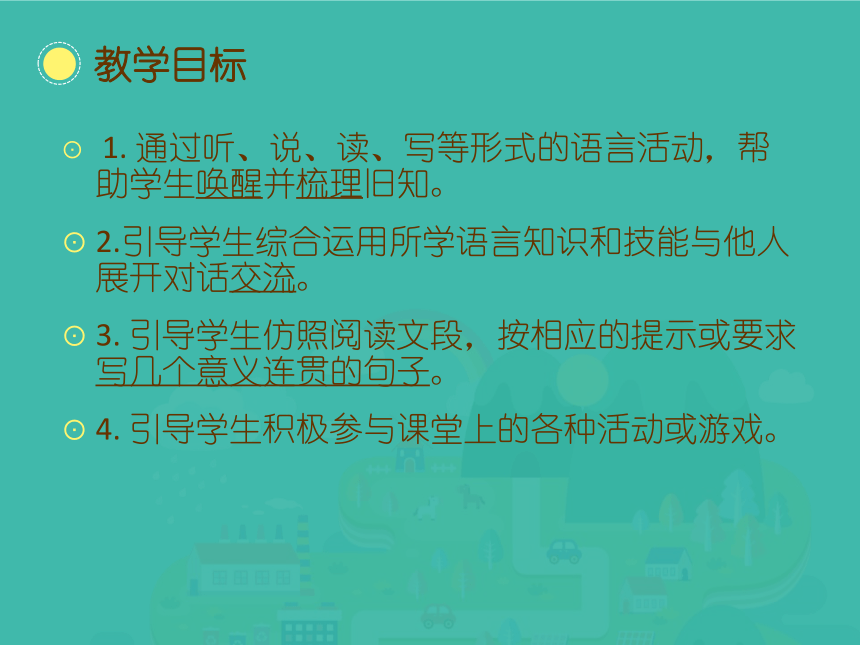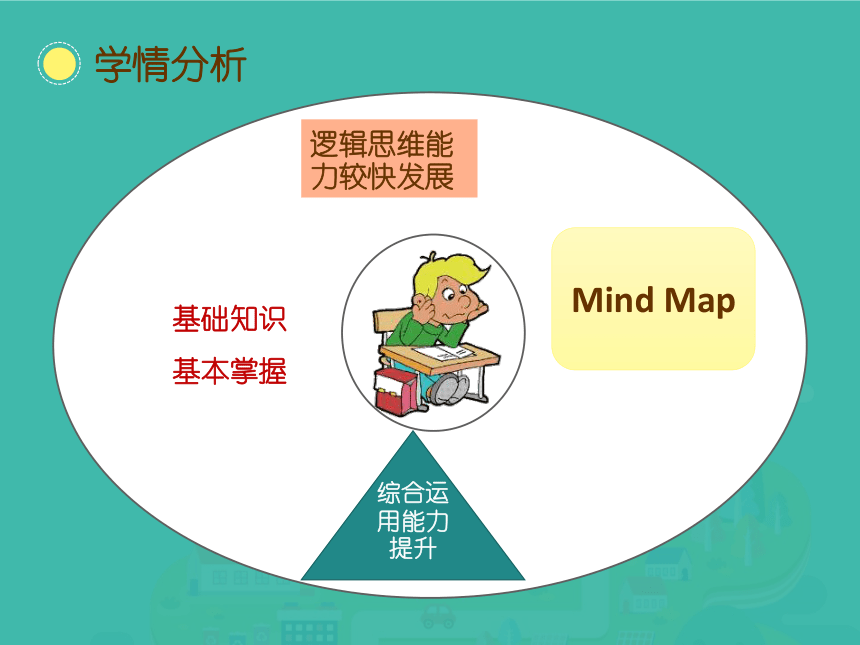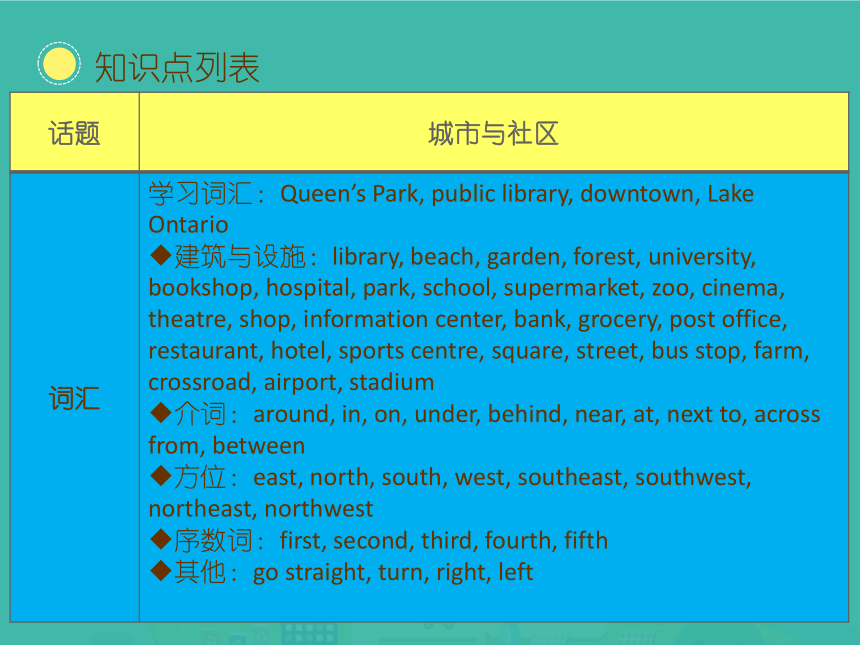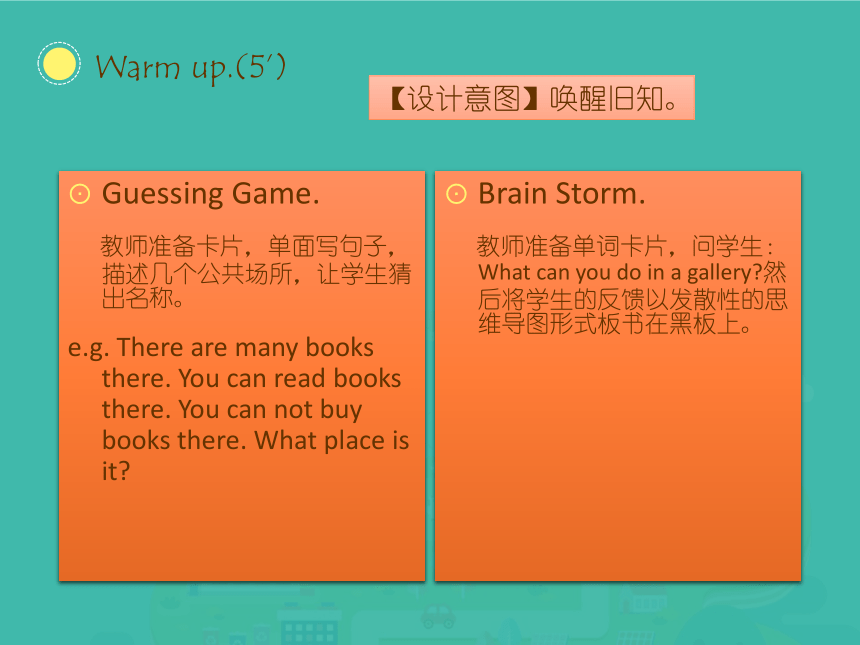Unit 2 All Around Me Lesson 1-3 教材分析课件(62张PPT)
文档属性
| 名称 | Unit 2 All Around Me Lesson 1-3 教材分析课件(62张PPT) |

|
|
| 格式 | pptx | ||
| 文件大小 | 8.1MB | ||
| 资源类型 | 教案 | ||
| 版本资源 | 人教(新起点) | ||
| 科目 | 英语 | ||
| 更新时间 | 2020-08-07 16:09:05 | ||
图片预览












文档简介
(共62张PPT)
Unit 2 All Around Me
Lesson 1-3教材分析
板块功能
第一层次的复习
(基础知识听说读写)
Lesson1
Lesson2
Lesson3
教学目标
1. 通过听、说、读、写等形式的语言活动,帮助学生唤醒并梳理旧知。
2.引导学生综合运用所学语言知识和技能与他人展开对话交流。
3. 引导学生仿照阅读文段,按相应的提示或要求写几个意义连贯的句子。
4. 引导学生积极参与课堂上的各种活动或游戏。
基础知识
基本掌握
学情分析
逻辑思维能力较快发展
综合运用能力提升
Mind Map
备课思考
如何帮助学生触类旁通地复习旧知?
如何设计活动帮助学生综合运用旧知进行阅读与交际?
教师在复习中的作用?
Lesson1
知识点列表
话题 城市与社区
功能句型 问路与指路
How can I go to the library
It’s on Pear Street. Go straight. Turn left at the second crossroads. It’s on your left.
谈论城市或社区中的建筑或设施
Is there a bookstore
Yes, there is. / No, there isn’t.
There are many / a lot of shops on the street.
There is a shop next to the cinema.
语法 使用There be句型谈论、介绍城市的建筑或设施
There be句型中be动词与可数名词单、复数的搭配,如:There is a shop. There are many shops.
使用介词介绍某建筑的位置。
知识点列表
话题 城市与社区
词汇 学习词汇:Queen’s Park, public library, downtown, Lake Ontario
建筑与设施:library, beach, garden, forest, university, bookshop, hospital, park, school, supermarket, zoo, cinema, theatre, shop, information center, bank, grocery, post office, restaurant, hotel, sports centre, square, street, bus stop, farm, crossroad, airport, stadium
介词:around, in, on, under, behind, near, at, next to, across from, between
方位:east, north, south, west, southeast, southwest, northeast, northwest
序数词:first, second, third, fourth, fifth
其他:go straight, turn, right, left
A项通过听力活动来复习有关Communities, Parks, Neighborhoods等话题的重点词汇和功能句。
B项通过信息差的活动引导学生谈论地图中的地点和方位。
C项呈现一篇阅读文章,引导学生通过阅读来复习有关Communities和Cities话题的知识。
D项是与C项相关的写作活动,仿照C项介绍自己家周围的环境。
Lesson1教学目标
1. 学生能梳理有Communities, Park, Neighborhoods和Cities等话题的词汇和功能句型;
2. 学生能根据地图或实际环境给他人指路;
3. 学生能根据地图或自己的实际情况,运用there be结构和方位介词笔头介绍社区的主要场所。
Lesson1教学流程
Step1:
Warm up.(5’)
Step2:
Listen and number.(8’)
Step3:
Let’s talk.(8’)
Step4:
Let’s read.(8’)
Step5:Let’s write.(11’)
Warm up.(5’)
Guessing Game.
教师准备卡片,单面写句子,描述几个公共场所,让学生猜出名称。
e.g. There are many books there. You can read books there. You can not buy books there. What place is it
Brain Storm.
教师准备单词卡片,问学生:What can you do in a gallery 然后将学生的反馈以发散性的思维导图形式板书在黑板上。
【设计意图】唤醒旧知。
A. Listen and number.(8’)
【设计意图】通过听对话录音,输入某建筑物所在位置的语言,复习与Communities, Parks, Neighborhoods等话题有关的重点词汇和功能句。
听前:教师引导学生看A项图片和文字,根据这些信息推测听力内容。What places do you see in part A What will Ted say to Bill
听中:录音播放两遍。
第一遍:听录音,标号,听完核对答案并就所听内容进行简单讨论,如:Where can you see Uncle Bob’s paintings 等。
第二遍:听录音,查漏补缺修正答案。
听后:同桌之间交换书本核对答案。
B: Ted. I want to send a postcard to my parents. Is there a post office near our house
T: Yes, there is. I’ll take you there. I can show you some of the city, too. Let’s go straight and turn right at the second crossroads. The post office is on the left.
B: There it is, Ted. What’s that building next to the post office Is it a bookshop
T: No, it’s a coffee shop. Look! Over there you can see a public library. It has many kinds of books.
B: That’s cool. Look at that building over there. What is it
T: It’s an art gallery. You can see Uncle Bob’s paintings there. But now, let’s go to Queen’s Park. It’s really famous and there are many trees there.
B: Oh, look! There’s a Chinese restaurant! I miss Chinese food.
B. Let’s talk.(8’)
【设计意图】通过制造信息差,让学生通过对话练习谈论地图
中的地点和方位。
步骤:
将学生分为A、B两组,让A组学生看Map1,B组学生看Map2,引导学生观察各自的地图,并提醒学生不能看对方的地图。
请两组学生进行对话示范,如:Is there a library in your map How can I get there 教师可将句型板书在黑板上或多媒体展示,供学生参考。
两人一组利用信息差进行对话。
随机选取几个小组演示对话。
C. Let’s read.(8’)
Ted is telling Bill about Yonge Street.
【设计意图】通过阅读文段,复习方位、建筑物名称相关的词汇和句型。
步骤:
观察地图,预测内容,明确任务;
阅读文段,在文中划出关键信息或直接在地图中填写建筑物名称;
借助图片复述文段(选)。
要求:
理解文段含义,提取有效信息;
会读图并理解方位;
正确抄写建筑物名称单词。
D. Let’s write.(11’)
【设计意图】综合考察学生对Communities, Parks和Neighborhood话题相关知识的掌握,包括方位介绍、建筑物名称等。
Draw a map of your neighborhood and write about it.
步骤:
引导学生画社区图(根据课时,可以让学生课下提前完成社区图,可用电脑画图)。
仿照C部分文段句式,描述自己的社区图,完成写作任务。(建议学生用不同句式表达,如:There is a …next to the bank. You can see a …near the lake.
请两到三位学生展示和朗读自己的社区图和文字。
Lesson2
知识点列表
话题 学校与课程
功能句型 谈论学校的名称
What’s the name of your school
I go to Willow Primary School.
谈论学校有哪些教室
What (other) rooms do you have in your school
We have music room and a library.
谈论房间位置
Where is the library
It’s on the first floor.
谈论学校的课程
What classes do you have
We have PE and music class.
谈论对某门课程的喜好和原因
What is your favorite class Why
My favorite class is PE. We learn ice-skating in PE class. It’s hard, but fun.
知识点列表
话题 学校与课程
词汇 学校房间及设施:art room, computer room, music room, science room, library, play ground, toilet, floor
课程:art, computer, maths, music, PE, science, Chinese, English
一周七天:Monday, Tuesday, Wednesday, Thursday, Friday, Saturday, Sunday
形容词:boring, interesting, cool, fantastic, wonderful, fun
某种课堂上能做的事情:play…, write…, learn to…, listen to…, watch cartoons, draw pictures, sing songs, dance, read stories, exercises, ask and answer questions, run, jump, study, speak
知识点列表
话题 学校与课程
语法 使用一般现在时讨论,介绍学校设施、课程等
使用形容词表达对某种课程的喜好程度
名词单、复数的使用,如:a library, music room
使用介词描述教室的位置
介词on的使用,如:on the first floor, on Sunday
A项通过听力活动复习School和School Subjects话题的重点词汇和功能句。
B项引导学生首先谈论A项内容,然后用A项内容谈论自己的相关情况。
C项引导学生通过阅读来复习有关School和School Subjects话题的知识。
D项在问题引导下的写作活动,引导学生介绍自己的学校生活。
Lesson2教学目标
1. 学生能梳理有关School和School Subjects等话题的重点词汇和功能句型;
2. 学生能根据实际情况为他人介绍某个房间的位置;
3. 学生能够根据School Subjects词汇、表示week的词汇和时间频度词汇理解文段含义提取有效信息;
4. 学生能根据方位图或实际情况,运用There be句型和方位介词笔头介绍学校各个教室的位置。
Lesson2教学流程
Step1:
Warm up.(3’)
Step2:
Listen and match.(8’)
Step3:
Let’s talk.(8’)
Step4:
Read and tick.(8’)
Step5:Let’s write.(13’)
Warm up.(3’)
Brain storm.
给出与School或School Subject话题相关的一个词,让学生说出几个同类词,如:music room或math
教师用气泡式思维导图板书,让学生对相关单词有直观感受,并一起读一读。
【设计意图】通过头脑风暴的形式激活学生相关话题词汇的旧知,为听力部分做准备。
A. Listen and match.(8’)
art room
science room
music room
office
classroom
library
Listen and match.(8’)
art room
science room
music room
computer room
classroom
library
听力材料填空
On the _______ floor, we have some classrooms. Our classroom is on the _________.
The computer room is _____ the ________ floor, _________ the art room and the music room.
The teacher’s office is ____ ____ _____ ______. It’s _______ the science room _____ the library.
【设计意图】本课听力部分较为简单,从理解听力材料到能写出关键词,是对听力部分进一步学习。培养学生听音写词的能力。
On the first floor, we have some classrooms. Our classroom is on the left.
The computer room is on the second floor, between the art room and the music room.
The teacher’s office is on the third floor. It’s between the science room and the library.
B. Let’s talk.(8’)
谈论A部分录音内容
谈论自己学校的情况
What other room do you have in your school Where are they
It’s on the ..floor. It’s next to/ between … and ….
Where is the music room in your school
We also have … in our school. They are ….
【设计意图】通过谈论Ted学校过渡到谈论自己学校,达到真实交流的训练目的。
C. Read and tick.(8’)
【设计意图】通过阅读复习关于科目、一周七天等词汇,并考察学生对相关语句表达的理解及信息提取能力。
C. Read and tick.(8’)
Q1. Describe the 2 pictures in the passage.
Q2. What class does Bill like Why
Q3. How often does Bill get homework How about you
D. Let’s write.(13’)
提示问题:
Q1: What is the name of your school
Q2: What rooms do you have in your school
Q3: Where is your classroom in your school
Q4: What classes do you have
Q5: What is your favorite class Why
写完后引导学生分享朗读自己写的短文。
【设计意图】在问题的提示下输出语言,综合考察学生对
School与School Subject话题知识的掌握与实际运用能力。
Write about your school.
favorite class
Lesson3
知识点列表
话题 老师与同学
功能句型 谈论最喜欢的老师与同学
Who is your favorite teacher/ classmate
My favorite teacher / classmate is Miss Jackson / Tony.
谈论某人外貌
What does Miss Jackson/ Tony / your best friend look like
She /He is short but pretty / handsome. She / He has black curly hair. She / He wears glasses.
语法 使用一般现在时讨论、介绍某人的外貌、特点、爱好等
一般现在时第三人称单数的动词变化,如:What does Tony look like He has black hair. He wears glasses. He plays basketball.
使用形容词描述人物外貌和性格特点
人称代词he, she, him, her的使用
知识点列表
话题 老师与同学
词汇 身体部位:ear, eye, face, mouth, nose, arm, foot(feet), hair, hand, head, leg
外貌形容词:beautiful, handsome, pretty, strong, old, young, short, tall, thin, slim, big, long, small, curly, straight
颜色:red, yellow, black, blue, white, grey
其他形容词:lovely, nice, cool, active, careless, clever, cute, friendly, helpful, polite, popular, quiet
兴趣、特长(动词短语):make models/ posters/ cards/ …, play sports/ badminton/ basketball/ football/ ping-pong(table tennis)/ chess/ computer games/ the piano/ the violin/…, go roller-skating/ hiking/ swimming/ fishing/ boating/ skiing/ camping/ skating/…, collect stamps, do puzzles/ visit museums/ write stories/ fly kites/ draw pictures/ read books/ listen to music/ watch TV/ jump rope/ pick fruit/ climb a hill/ see films/ take photos/ go for a picnic/ sing songs/ dance
其他:teacher/ classmate/ friend/ glasses
A项通过听力活动复习Friends, Classmates和Teachers等话题的重点词汇和功能句。
B项引导学生首先谈论在A项听到的内容,再引导学生根据A项的语言谈论自己的情况。
C项引导学生通过阅读文章来复习描述人物特征的语言。
D项在问题引导下进行写作,介绍自己最喜欢的教师或同学。
Lesson3教学目标
1. 学生能够梳理有关Friends, Classmates和Teachers等话题的重点词汇和功能句。
2. 学生能够就他人外貌、性格进行简单谈论。
3. 学生能在理解文段的基础上,简单谈论或复述某人的外貌与性格。
4. 学生能在问题的提示下,运用表示外貌、性格等词汇,写一段文字介绍自己最喜欢的教师或同学。
Lesson3教学流程
Step1:
Warm up.(3’)
Step2:
Listen and write the names.(8’)
Step3:
Let’s talk.(8’)
Step4:
Let’s read.(8’)
Step5:Let’s write.(13’)
Find the differences.(3’)
Talk about the two famous people.(appearance, personality, job)
【设计意图】通过谈论两位名人的区别,复习有关外貌、性格、擅长做的事等词汇和句型表达。
A. Listen and write the names.(8’)
听前活动:描述三个人的外表
long, blond, curly hair
tall, slim, pretty
short, blond, straight hair, short, handsome
long, black, curly hair,
tall, slim, pretty, young
【设计意图】通过听力活动复习有关Friends,Classmates和Teachers等话题的词汇和功能句型。
A. Listen and write the names.(8’)
Sherry
Tony
Miss Jackson
听中活动:听对话,写人名。
A. Listen and write the names.(8’)
Sherry
active, hardworking,
likes reading
Tony
popular, helpful
Miss Jackson
nice
听后活动:互动问答,讨论新老师和同学的性格特点。
B. Let’s talk.(8’)
Tips:课前准备假期作业英语小报My Favorite Teacher
Who is your favorite teacher/ friend
What does he/ she look like
personality
appearance
job
hobby
【设计意图】通过A部分听力部分材料过渡到谈论自己的真实情况,使学生掌握这些词汇和语句在实际交流中的使用方法。
C. Let’s read.(8’)
读文段,划一划,说一说。
【设计意图】通过阅读和讨论复习描述人物特征的语言。
D. Let’s write.(13’)
根据B部分说的内容写一写;
借助问题提示写一写;
Q1: Who is your favorite teacher or classmate
Q2: What does he/ she look like
Q3: Why do you like him/ her
可以提供word box;
如果提前布置了如上的英语小报,就可以把写作活动换作在投影下和小组内分享展示自己的作业,然后优化自己的小报(改错、装饰等)并在班级展出。
【设计意图】通过写作练习学生对该话题语言的笔头输出。
综合分析
如何帮助学生触类旁通地复习旧知?
复习到某一类词汇(如外表的词汇),将同一类词以word box的形式提供给学生,在写作环节运用。
热身环节教师提供一个单词,让学生进行发散思维训练,回忆并说出同一类词,老师板书并引导学生朗读。在课上还会安排学生进行读、写训练。
如何设计活动帮助学生综合运用旧知进行阅读与交际?
提前为学生布置一些任务(如小报),让学生在课上可以直接拿来与人交流使用,成功率较高,学生会非常有成就感。
教师在复习中的作用?
引导、推进、督促
八大图示法
学生作品——Butterfly
词汇
话题
语音
写作
Unit 2 All Around Me
Lesson 1-3教材分析
板块功能
第一层次的复习
(基础知识听说读写)
Lesson1
Lesson2
Lesson3
教学目标
1. 通过听、说、读、写等形式的语言活动,帮助学生唤醒并梳理旧知。
2.引导学生综合运用所学语言知识和技能与他人展开对话交流。
3. 引导学生仿照阅读文段,按相应的提示或要求写几个意义连贯的句子。
4. 引导学生积极参与课堂上的各种活动或游戏。
基础知识
基本掌握
学情分析
逻辑思维能力较快发展
综合运用能力提升
Mind Map
备课思考
如何帮助学生触类旁通地复习旧知?
如何设计活动帮助学生综合运用旧知进行阅读与交际?
教师在复习中的作用?
Lesson1
知识点列表
话题 城市与社区
功能句型 问路与指路
How can I go to the library
It’s on Pear Street. Go straight. Turn left at the second crossroads. It’s on your left.
谈论城市或社区中的建筑或设施
Is there a bookstore
Yes, there is. / No, there isn’t.
There are many / a lot of shops on the street.
There is a shop next to the cinema.
语法 使用There be句型谈论、介绍城市的建筑或设施
There be句型中be动词与可数名词单、复数的搭配,如:There is a shop. There are many shops.
使用介词介绍某建筑的位置。
知识点列表
话题 城市与社区
词汇 学习词汇:Queen’s Park, public library, downtown, Lake Ontario
建筑与设施:library, beach, garden, forest, university, bookshop, hospital, park, school, supermarket, zoo, cinema, theatre, shop, information center, bank, grocery, post office, restaurant, hotel, sports centre, square, street, bus stop, farm, crossroad, airport, stadium
介词:around, in, on, under, behind, near, at, next to, across from, between
方位:east, north, south, west, southeast, southwest, northeast, northwest
序数词:first, second, third, fourth, fifth
其他:go straight, turn, right, left
A项通过听力活动来复习有关Communities, Parks, Neighborhoods等话题的重点词汇和功能句。
B项通过信息差的活动引导学生谈论地图中的地点和方位。
C项呈现一篇阅读文章,引导学生通过阅读来复习有关Communities和Cities话题的知识。
D项是与C项相关的写作活动,仿照C项介绍自己家周围的环境。
Lesson1教学目标
1. 学生能梳理有Communities, Park, Neighborhoods和Cities等话题的词汇和功能句型;
2. 学生能根据地图或实际环境给他人指路;
3. 学生能根据地图或自己的实际情况,运用there be结构和方位介词笔头介绍社区的主要场所。
Lesson1教学流程
Step1:
Warm up.(5’)
Step2:
Listen and number.(8’)
Step3:
Let’s talk.(8’)
Step4:
Let’s read.(8’)
Step5:Let’s write.(11’)
Warm up.(5’)
Guessing Game.
教师准备卡片,单面写句子,描述几个公共场所,让学生猜出名称。
e.g. There are many books there. You can read books there. You can not buy books there. What place is it
Brain Storm.
教师准备单词卡片,问学生:What can you do in a gallery 然后将学生的反馈以发散性的思维导图形式板书在黑板上。
【设计意图】唤醒旧知。
A. Listen and number.(8’)
【设计意图】通过听对话录音,输入某建筑物所在位置的语言,复习与Communities, Parks, Neighborhoods等话题有关的重点词汇和功能句。
听前:教师引导学生看A项图片和文字,根据这些信息推测听力内容。What places do you see in part A What will Ted say to Bill
听中:录音播放两遍。
第一遍:听录音,标号,听完核对答案并就所听内容进行简单讨论,如:Where can you see Uncle Bob’s paintings 等。
第二遍:听录音,查漏补缺修正答案。
听后:同桌之间交换书本核对答案。
B: Ted. I want to send a postcard to my parents. Is there a post office near our house
T: Yes, there is. I’ll take you there. I can show you some of the city, too. Let’s go straight and turn right at the second crossroads. The post office is on the left.
B: There it is, Ted. What’s that building next to the post office Is it a bookshop
T: No, it’s a coffee shop. Look! Over there you can see a public library. It has many kinds of books.
B: That’s cool. Look at that building over there. What is it
T: It’s an art gallery. You can see Uncle Bob’s paintings there. But now, let’s go to Queen’s Park. It’s really famous and there are many trees there.
B: Oh, look! There’s a Chinese restaurant! I miss Chinese food.
B. Let’s talk.(8’)
【设计意图】通过制造信息差,让学生通过对话练习谈论地图
中的地点和方位。
步骤:
将学生分为A、B两组,让A组学生看Map1,B组学生看Map2,引导学生观察各自的地图,并提醒学生不能看对方的地图。
请两组学生进行对话示范,如:Is there a library in your map How can I get there 教师可将句型板书在黑板上或多媒体展示,供学生参考。
两人一组利用信息差进行对话。
随机选取几个小组演示对话。
C. Let’s read.(8’)
Ted is telling Bill about Yonge Street.
【设计意图】通过阅读文段,复习方位、建筑物名称相关的词汇和句型。
步骤:
观察地图,预测内容,明确任务;
阅读文段,在文中划出关键信息或直接在地图中填写建筑物名称;
借助图片复述文段(选)。
要求:
理解文段含义,提取有效信息;
会读图并理解方位;
正确抄写建筑物名称单词。
D. Let’s write.(11’)
【设计意图】综合考察学生对Communities, Parks和Neighborhood话题相关知识的掌握,包括方位介绍、建筑物名称等。
Draw a map of your neighborhood and write about it.
步骤:
引导学生画社区图(根据课时,可以让学生课下提前完成社区图,可用电脑画图)。
仿照C部分文段句式,描述自己的社区图,完成写作任务。(建议学生用不同句式表达,如:There is a …next to the bank. You can see a …near the lake.
请两到三位学生展示和朗读自己的社区图和文字。
Lesson2
知识点列表
话题 学校与课程
功能句型 谈论学校的名称
What’s the name of your school
I go to Willow Primary School.
谈论学校有哪些教室
What (other) rooms do you have in your school
We have music room and a library.
谈论房间位置
Where is the library
It’s on the first floor.
谈论学校的课程
What classes do you have
We have PE and music class.
谈论对某门课程的喜好和原因
What is your favorite class Why
My favorite class is PE. We learn ice-skating in PE class. It’s hard, but fun.
知识点列表
话题 学校与课程
词汇 学校房间及设施:art room, computer room, music room, science room, library, play ground, toilet, floor
课程:art, computer, maths, music, PE, science, Chinese, English
一周七天:Monday, Tuesday, Wednesday, Thursday, Friday, Saturday, Sunday
形容词:boring, interesting, cool, fantastic, wonderful, fun
某种课堂上能做的事情:play…, write…, learn to…, listen to…, watch cartoons, draw pictures, sing songs, dance, read stories, exercises, ask and answer questions, run, jump, study, speak
知识点列表
话题 学校与课程
语法 使用一般现在时讨论,介绍学校设施、课程等
使用形容词表达对某种课程的喜好程度
名词单、复数的使用,如:a library, music room
使用介词描述教室的位置
介词on的使用,如:on the first floor, on Sunday
A项通过听力活动复习School和School Subjects话题的重点词汇和功能句。
B项引导学生首先谈论A项内容,然后用A项内容谈论自己的相关情况。
C项引导学生通过阅读来复习有关School和School Subjects话题的知识。
D项在问题引导下的写作活动,引导学生介绍自己的学校生活。
Lesson2教学目标
1. 学生能梳理有关School和School Subjects等话题的重点词汇和功能句型;
2. 学生能根据实际情况为他人介绍某个房间的位置;
3. 学生能够根据School Subjects词汇、表示week的词汇和时间频度词汇理解文段含义提取有效信息;
4. 学生能根据方位图或实际情况,运用There be句型和方位介词笔头介绍学校各个教室的位置。
Lesson2教学流程
Step1:
Warm up.(3’)
Step2:
Listen and match.(8’)
Step3:
Let’s talk.(8’)
Step4:
Read and tick.(8’)
Step5:Let’s write.(13’)
Warm up.(3’)
Brain storm.
给出与School或School Subject话题相关的一个词,让学生说出几个同类词,如:music room或math
教师用气泡式思维导图板书,让学生对相关单词有直观感受,并一起读一读。
【设计意图】通过头脑风暴的形式激活学生相关话题词汇的旧知,为听力部分做准备。
A. Listen and match.(8’)
art room
science room
music room
office
classroom
library
Listen and match.(8’)
art room
science room
music room
computer room
classroom
library
听力材料填空
On the _______ floor, we have some classrooms. Our classroom is on the _________.
The computer room is _____ the ________ floor, _________ the art room and the music room.
The teacher’s office is ____ ____ _____ ______. It’s _______ the science room _____ the library.
【设计意图】本课听力部分较为简单,从理解听力材料到能写出关键词,是对听力部分进一步学习。培养学生听音写词的能力。
On the first floor, we have some classrooms. Our classroom is on the left.
The computer room is on the second floor, between the art room and the music room.
The teacher’s office is on the third floor. It’s between the science room and the library.
B. Let’s talk.(8’)
谈论A部分录音内容
谈论自己学校的情况
What other room do you have in your school Where are they
It’s on the ..floor. It’s next to/ between … and ….
Where is the music room in your school
We also have … in our school. They are ….
【设计意图】通过谈论Ted学校过渡到谈论自己学校,达到真实交流的训练目的。
C. Read and tick.(8’)
【设计意图】通过阅读复习关于科目、一周七天等词汇,并考察学生对相关语句表达的理解及信息提取能力。
C. Read and tick.(8’)
Q1. Describe the 2 pictures in the passage.
Q2. What class does Bill like Why
Q3. How often does Bill get homework How about you
D. Let’s write.(13’)
提示问题:
Q1: What is the name of your school
Q2: What rooms do you have in your school
Q3: Where is your classroom in your school
Q4: What classes do you have
Q5: What is your favorite class Why
写完后引导学生分享朗读自己写的短文。
【设计意图】在问题的提示下输出语言,综合考察学生对
School与School Subject话题知识的掌握与实际运用能力。
Write about your school.
favorite class
Lesson3
知识点列表
话题 老师与同学
功能句型 谈论最喜欢的老师与同学
Who is your favorite teacher/ classmate
My favorite teacher / classmate is Miss Jackson / Tony.
谈论某人外貌
What does Miss Jackson/ Tony / your best friend look like
She /He is short but pretty / handsome. She / He has black curly hair. She / He wears glasses.
语法 使用一般现在时讨论、介绍某人的外貌、特点、爱好等
一般现在时第三人称单数的动词变化,如:What does Tony look like He has black hair. He wears glasses. He plays basketball.
使用形容词描述人物外貌和性格特点
人称代词he, she, him, her的使用
知识点列表
话题 老师与同学
词汇 身体部位:ear, eye, face, mouth, nose, arm, foot(feet), hair, hand, head, leg
外貌形容词:beautiful, handsome, pretty, strong, old, young, short, tall, thin, slim, big, long, small, curly, straight
颜色:red, yellow, black, blue, white, grey
其他形容词:lovely, nice, cool, active, careless, clever, cute, friendly, helpful, polite, popular, quiet
兴趣、特长(动词短语):make models/ posters/ cards/ …, play sports/ badminton/ basketball/ football/ ping-pong(table tennis)/ chess/ computer games/ the piano/ the violin/…, go roller-skating/ hiking/ swimming/ fishing/ boating/ skiing/ camping/ skating/…, collect stamps, do puzzles/ visit museums/ write stories/ fly kites/ draw pictures/ read books/ listen to music/ watch TV/ jump rope/ pick fruit/ climb a hill/ see films/ take photos/ go for a picnic/ sing songs/ dance
其他:teacher/ classmate/ friend/ glasses
A项通过听力活动复习Friends, Classmates和Teachers等话题的重点词汇和功能句。
B项引导学生首先谈论在A项听到的内容,再引导学生根据A项的语言谈论自己的情况。
C项引导学生通过阅读文章来复习描述人物特征的语言。
D项在问题引导下进行写作,介绍自己最喜欢的教师或同学。
Lesson3教学目标
1. 学生能够梳理有关Friends, Classmates和Teachers等话题的重点词汇和功能句。
2. 学生能够就他人外貌、性格进行简单谈论。
3. 学生能在理解文段的基础上,简单谈论或复述某人的外貌与性格。
4. 学生能在问题的提示下,运用表示外貌、性格等词汇,写一段文字介绍自己最喜欢的教师或同学。
Lesson3教学流程
Step1:
Warm up.(3’)
Step2:
Listen and write the names.(8’)
Step3:
Let’s talk.(8’)
Step4:
Let’s read.(8’)
Step5:Let’s write.(13’)
Find the differences.(3’)
Talk about the two famous people.(appearance, personality, job)
【设计意图】通过谈论两位名人的区别,复习有关外貌、性格、擅长做的事等词汇和句型表达。
A. Listen and write the names.(8’)
听前活动:描述三个人的外表
long, blond, curly hair
tall, slim, pretty
short, blond, straight hair, short, handsome
long, black, curly hair,
tall, slim, pretty, young
【设计意图】通过听力活动复习有关Friends,Classmates和Teachers等话题的词汇和功能句型。
A. Listen and write the names.(8’)
Sherry
Tony
Miss Jackson
听中活动:听对话,写人名。
A. Listen and write the names.(8’)
Sherry
active, hardworking,
likes reading
Tony
popular, helpful
Miss Jackson
nice
听后活动:互动问答,讨论新老师和同学的性格特点。
B. Let’s talk.(8’)
Tips:课前准备假期作业英语小报My Favorite Teacher
Who is your favorite teacher/ friend
What does he/ she look like
personality
appearance
job
hobby
【设计意图】通过A部分听力部分材料过渡到谈论自己的真实情况,使学生掌握这些词汇和语句在实际交流中的使用方法。
C. Let’s read.(8’)
读文段,划一划,说一说。
【设计意图】通过阅读和讨论复习描述人物特征的语言。
D. Let’s write.(13’)
根据B部分说的内容写一写;
借助问题提示写一写;
Q1: Who is your favorite teacher or classmate
Q2: What does he/ she look like
Q3: Why do you like him/ her
可以提供word box;
如果提前布置了如上的英语小报,就可以把写作活动换作在投影下和小组内分享展示自己的作业,然后优化自己的小报(改错、装饰等)并在班级展出。
【设计意图】通过写作练习学生对该话题语言的笔头输出。
综合分析
如何帮助学生触类旁通地复习旧知?
复习到某一类词汇(如外表的词汇),将同一类词以word box的形式提供给学生,在写作环节运用。
热身环节教师提供一个单词,让学生进行发散思维训练,回忆并说出同一类词,老师板书并引导学生朗读。在课上还会安排学生进行读、写训练。
如何设计活动帮助学生综合运用旧知进行阅读与交际?
提前为学生布置一些任务(如小报),让学生在课上可以直接拿来与人交流使用,成功率较高,学生会非常有成就感。
教师在复习中的作用?
引导、推进、督促
八大图示法
学生作品——Butterfly
词汇
话题
语音
写作
